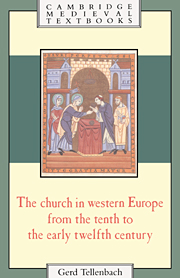Book contents
- Frontmatter
- Contents
- Translator's note
- Author's preface
- List of abbreviations
- 1 Western Christendom and its environment in the tenth and eleventh centuries
- 2 The church and its manifestations on earth
- 3 The material existence of the churches and the clergy
- 4 Religious life and thought
- 5 The beginnings of the revolution in church history
- 6 Gregory VII (1073–1085)
- 7 Continuing conflicts between established principles
- 8 Pope, church, and Christendom
- Epilogue
- Select bibliography
- Index
- Cambridge Medieval Textbooks
1 - Western Christendom and its environment in the tenth and eleventh centuries
Published online by Cambridge University Press: 05 June 2012
- Frontmatter
- Contents
- Translator's note
- Author's preface
- List of abbreviations
- 1 Western Christendom and its environment in the tenth and eleventh centuries
- 2 The church and its manifestations on earth
- 3 The material existence of the churches and the clergy
- 4 Religious life and thought
- 5 The beginnings of the revolution in church history
- 6 Gregory VII (1073–1085)
- 7 Continuing conflicts between established principles
- 8 Pope, church, and Christendom
- Epilogue
- Select bibliography
- Index
- Cambridge Medieval Textbooks
Summary
THE INTERNAL AND EXTERNAL SECURITY OF WESTERN CHRISTENDOM
Viewed from the standpoint of comparative history, Christendom in these two centuries seems to have been a fairly united and uniform community of faith, at least in the West, and in spite of numerous lost struggles on the margins its existence was not seriously threatened from outside.
Following the controversies between Paschasius Radbertus of Corbie and his supporters on the one hand and the theologians like Hrabanus Maurus, Ratramnus, or Gottschalk on the other over the Eucharist there were no serious disputes over dogma. Not until the debate over Berengar of Tours's doctrine of the Eucharist in the middle of the eleventh century was there a revival of such disputes, and from then on early scholastic theology developed through a series of dogmatic controversies. Ancient relicts of paganism, residual elements of the old religions, and, still more, the continuing pagan practices of the newly converted proved hard to eradicate; but these things were not a serious threat to the Christian peoples. From the acceptance of Christianity to its internalisation, to a genuine absorption of Christian faith and morality, as these were then understood, there often lay a long and winding path. Heresies occurred here and there from the eleventh century on, but in the period under discussion they were not yet a serious danger. More frequent were meaningless accusations of heresy in the course of political or ecclesiastical propaganda, but even these were not so numerous or so hate-filled as they were to become from the late eleventh century on.
- Type
- Chapter
- Information
- Publisher: Cambridge University PressPrint publication year: 1993



